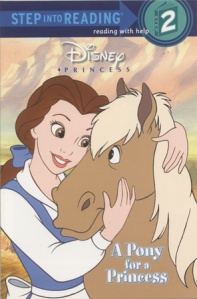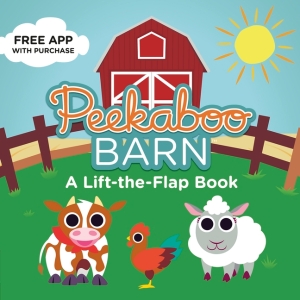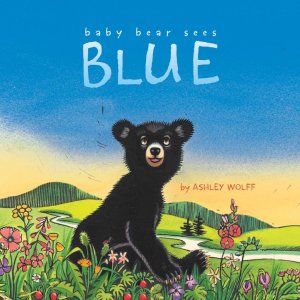Away in a Manger illustrated by Lisa Reed and Randle Paul Bennett. Candy Cane-Ideals, 2012. Intended audience: Ages 3-5.
The text and audio of this book are the first two verses of “Away in a Manger,” sung by “Junior Asparagus,” who is unfortunately one of my least favorite musical talents among the VeggieTales cast. The illustrations are bright and colorful, and VeggieTales fans will appreciate seeing familiar faces in a probably equally familiar tableau. I witnessed one parent trying to read this book (or it might have been its sister book, Silent Night) to a child, and stumbling to an awkward halt when it turned out that the audio button was the text in its entirety. That rather detracts from the book’s ability to lead to interaction between a parent and child. A parent can turn the pages, but the time spent on each page is limited and the parent’s voice is lost amid Junior’s warble.
*
Step Into Reading: Level 2: A Pony for a Princess by Andrea Posner-Sanchez and illustrated by Francesc Mateu. RH Disney-Random 2002.
I was drawn to the book by the promise of a pony but was a little worried by the book being a Disney spinoff. I was more impressed with this book than I expected to be. The plot is well formed. A deductive thinker could reason the plot from details. Belle sees a barrel of apples, and later decides to return to the barrel to sate her hunger, only to find the barrel empty, then logically she seeks to discover what happened to the apples. I do think it unlikely that a wild pony could be so easily caught by a trail of sugar cubes, but this is a Disney story, and Belle qualifies as a Disney princess, so I will forgive the implausibility and call it more of an inevitability.
****
Good Night, Gorilla by Peggy Rathmann. G.P Putnam & Sons-Penguin Putnam, 1996. First published 1994. Intended audience: Ages 3-5.
This was at least a second read. Good Night, Gorilla is something of a classic. I think the illustrations are what make this book. The zookeeper goes about saying goodnight to the animals (making it a plausible animal primer), but on the first page, the gorilla steals his keys and follows him through the zoo, unlocking cages. The whole of the zoo follows him home and into his bedroom. Too many responses to her “Good night, dear” alert the zookeeper’s wife of the trouble, and she calmly gets up out of bed, takes the gorilla’s hand, and leads all the animals back to their cages. The gorilla and the mouse escape even her watch and follow her once more back to the bed that she shares with the zookeeper. I appreciate the presentation of a more alert, more able wife.
***
Peekaboo Barn by Nat Sims and illustrated by Nathan Tabor. Candlewick, 2014. Intended audience: Ages 0-3, PreK.
This lift-the-flap animal primer comes with a free app download code. This is the first of a few books I’ve since come across with app companions. Apparently, this book was an app first. The animals are cartoonish with bug eyes that are mildly disturbing. Sometimes there’s only one flap on a page, sometimes there are two. At first read, this was confusing, as I didn’t know to look for two flaps and would open the barn doors to discover only one of the animals whose sounds I’d just read. Then I noticed that the loft doors also occasionally opened. I’m not sure if as a toddler reader, this variation would be exciting or confusing. If I’m being finicky, the animals are not seen or entering the barn, but the scene never changes, the sun never moves across the sky. It would have been very simple to introduce more plot into this book.
*
That’s Not My Snowman… by Fiona Watt. Usborne, 2014. First published 2006.
There’s not much exciting about this winter edition of a series of touch-and-feel primers that spans all manner of creature, machine, and… sculpture. I do puzzle what sort of squishy nose one could give a snowman. I prefer to have logical connections between the illustrations and text. The inclusion of the ever-present mouse in this series adds a nice element of continuity to the story and the series.
**
An Elephant and Piggie Book: Waiting Is Not Easy! by Mo Willems. Disney-Hyperion, 2014. Intended audience: Ages 6-8.
I was pleasantly surprised by this book. I am a fan of Mo Willems and of Elephant and Piggie in particular. I was not expecting the mixed media illustrations in this book nor the subtle hint of the passage of time as the white space becomes darker. I think both the messages of patience and of the beauty of nature are valuable to today’s children, so used—as we all are—to instant gratification. I like it even better on a second reading, particularly I enjoy Piggie’s answers to Gerald’s questions Piggie about the surprise.
*****
Baby Bear Sees Blue by Ashley Wolff. Little Simon-Simon & Schuster, 2014. First published 2012. Intended audience: Ages 2-6, Grades PreK-1.
I am biased towards Wolff’s books and this one in particular. Wolff is a professor at my alma mater. This book I saw as an unbound proof when she read it to us. I saw it later read at a local library story hour and witnessed the unbiased enjoyment of it from the children and the librarian. Wolff’s illustrations are jewel bright, and the text does not seem overly formulaic as many primers can seem, though Wolff does keep some repetition in the line “Baby Bear sees [color]” to give the story a familiar structure and rhythm. Wolff does not shy from poetic language within her text, but she keeps true too to the toddler understanding of the world with Baby Bear’s speech, as when Baby Bear asks who is waving at him, indicating an oak leaf stirred by a breeze. I had not considered till reading a particularly detailed review on Goodreads that the closing line makes the book fit appropriately too into the bedtime story mold.
****
These reviews are not endorsed by any one involved in their making. They are independent, honest reviews by a reader.







